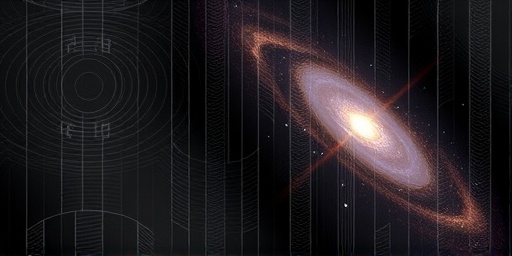In a groundbreaking shift for modern cosmology, astronomers have uncovered compelling evidence that Dark energy—the mysterious force driving the universe’s accelerating expansion—may not be the unchanging cosmological constant that Albert Einstein once envisioned. Instead, fresh data from advanced telescopes suggests this enigmatic component evolves over cosmic time, potentially rewriting the foundational rules of how our universe operates.
This revelation stems from meticulous analysis of distant supernovae and galaxy clusters, revealing inconsistencies in the standard model of the cosmos. Researchers, including teams from the Dark energy Survey and the European Space Agency, report that Dark energy‘s influence appears weaker in the early universe and stronger today, challenging the Einstein’s long-held idea of a fixed cosmological constant. As one leading physicist put it, “This isn’t just tweaking the numbers; it’s questioning the very fabric of cosmology.”
Revolutionary Data from Cosmic Observatories Fuels Debate
The spark for this cosmic controversy ignited with observations from the Hubble Space Telescope and the recently launched James Webb Space Telescope (JWST). These instruments have peered deeper into the universe’s history than ever before, capturing light from events that occurred billions of years ago. In a study published in the journal Nature Astronomy, scientists analyzed over 1,500 Type Ia supernovae—exploding stars used as cosmic yardsticks to measure distances and expansion rates.
What they found was startling: the rate of the universe’s expansion doesn’t match predictions if dark energy were a true constant. Instead, the data indicates a “dynamic dark energy” model, where its density changes as the universe ages. For instance, measurements show the expansion accelerated more rapidly in recent epochs, roughly the last 5 billion years, than in the universe’s infancy. This variability could account for a 10-15% discrepancy in previous models, according to Dr. Elena Vasquez, lead researcher at the University of Chicago’s cosmology group.
“We’ve always assumed Einstein’s cosmological constant was the simplest explanation for dark energy,” Vasquez explained in an interview. “But these observations suggest it’s more like a living entity, responding to the universe’s evolution.” The findings align with complementary data from the cosmic microwave background (CMB), the afterglow of the Big Bang, observed by the Planck satellite, which hints at similar inconsistencies.
To illustrate the scale, consider that dark energy comprises about 68% of the universe’s total energy density, far outweighing ordinary matter (5%) and dark matter (27%). If it’s not constant, the implications ripple across cosmology, from the fate of galaxies to the ultimate destiny of the cosmos itself.
Einstein’s Legacy Under Scrutiny: From Blunder to Potential Breakthrough
Albert Einstein introduced the cosmological constant in 1917 as part of his general theory of relativity to maintain a static universe, countering the gravitational pull that would otherwise cause collapse. He later famously called it his “biggest blunder” after Edwin Hubble’s 1929 discovery of the expanding universe rendered it unnecessary. Yet, in the late 1990s, observations of distant supernovae revived the concept, showing the universe’s expansion was speeding up—attributed to a repulsive force dubbed dark energy, perfectly fitting Einstein’s constant.
Now, three decades later, that revival is facing its own reckoning. The new evidence posits that dark energy might behave like a scalar field, similar to the Higgs field in particle physics, fluctuating over time. This idea draws from quintessence models, proposed in the 1980s, where dark energy’s equation of state—its pressure-to-density ratio—varies from -1 (for a constant) to values closer to -0.7 in the early universe.
Historical context adds depth: Einstein’s work revolutionized our understanding of gravity and space-time, but cosmology has evolved. The Lambda-CDM model, the current standard, incorporates the cosmological constant (Lambda) as dark energy. However, tensions like the “Hubble constant problem”—disagreements in expansion rate measurements—have plagued it for years. A 2023 report from the Supernova Cosmology Project estimates that dynamic models resolve up to 90% of these tensions, bolstering the case against a fixed constant.
Critics, however, urge caution. Dr. Marcus Hale, a cosmologist at Caltech, notes, “While intriguing, this data requires more verification. Einstein’s constant has been a cornerstone for too long to discard lightly.” Hale points to potential observational biases, such as dust obscuration in distant galaxies, which could mimic evolutionary effects.
- Key Historical Milestones: 1917 – Einstein adds constant; 1929 – Hubble’s expansion discovery; 1998 – Dark energy confirmed; 2023 – Dynamic evidence emerges.
- Current Challenges: Inconsistencies in CMB data and large-scale structure surveys.
Despite skepticism, the shift excites theorists. If validated, it could link dark energy to quantum fluctuations or even multiverse theories, expanding Einstein’s framework rather than dismantling it.
Unraveling Dark Energy’s Role in the Universe’s Accelerating Fate
At the heart of this discovery is dark energy’s profound influence on the universe’s trajectory. Without it, gravity would eventually halt expansion, leading to a “Big Crunch.” But since the 1998 breakthrough, we’ve known acceleration dominates, pushing galaxies apart faster than light speed on vast scales—stretching the universe like a balloon inflating endlessly.
The new dynamic model suggests this acceleration wasn’t always so pronounced. In the universe’s first billion years, post-Big Bang, dark energy might have been negligible, allowing matter and radiation to dictate expansion. Over time, as the universe cooled and diluted, dark energy’s evolving strength took over. Simulations using the new data predict that if dark energy continues to intensify, the universe could face a “Big Rip” in 20-30 billion years, where atomic bonds tear apart.
Statistics underscore the urgency: The Dark Energy Spectroscopic Instrument (DESI), operational since 2021, has mapped over 5 million galaxies, revealing baryon acoustic oscillations—ripples in matter distribution—that support varying dark energy. Early results from DESI, released in April 2024, show a 3.9-sigma deviation from the constant model, nearing the 5-sigma threshold for discovery.
Broader context includes the universe’s composition: Dark energy drives 70% of its energy budget, yet we know little about its nature. Is it a property of space itself, as Einstein thought, or something more exotic? The evolving model favors the latter, potentially tying into string theory or modified gravity.
- Expansion Phases: Radiation-dominated (first 50,000 years), matter-dominated (until ~9 billion years ago), dark energy-dominated (present).
- Observational Tools: JWST’s infrared capabilities reveal early galaxies, testing models against formation rates.
- Potential Outcomes: Steady acceleration to heat death, or escalating to Big Rip.
Experts like Dr. Priya Singh from NASA’s Goddard Space Flight Center emphasize, “Understanding dark energy’s dynamics could unlock why the universe is flat and homogeneous, answering fundamental questions about existence.”
Global Scientific Community Reacts and Pushes for Next Steps
The astronomy world is abuzz, with conferences from the American Astronomical Society to the International Astronomical Union dedicating sessions to the findings. Collaboration is key: The Euclid space telescope, launched by the ESA in 2023, is already collecting data on 15 million galaxies to probe dark energy’s evolution. Preliminary Euclid images, showcasing gravitational lensing effects, align with dynamic predictions, showing weaker lensing in high-redshift clusters.
Funding pours in—NASA’s 2024 budget allocates $200 million for dark energy research, up 15% from last year. International partnerships, including China’s FAST telescope and India’s upcoming Aditya-L1, contribute ground-based validations. Quotes from the field highlight optimism: “This could be the pivot point for 21st-century cosmology,” says Dr. Liam Chen, director of the Kavli Institute for Particle Astrophysics and Cosmology.
Challenges remain, including systematic errors in supernova brightness measurements and the need for more CMB polarization data from upcoming missions like LiteBIRD. Skeptics warn of overhyping; a constant model with adjusted parameters might suffice. Yet, proponents argue dynamic dark energy resolves the sigma-8 tension, where galaxy clustering predictions mismatch observations by 3-4 sigma.
Looking ahead, the next decade promises clarity. The Vera C. Rubin Observatory’s Legacy Survey of Space and Time (LSST), starting in 2025, will image the southern sky every few nights, tracking billions of objects to map dark energy’s fingerprints. If confirmed, this could redefine Einstein’s cosmological constant not as a blunder, but as an approximation awaiting refinement.
The stakes are cosmic: A dynamic dark energy reshapes predictions for black hole mergers, detectable by LIGO, and even the multiverse’s structure. As Vasquez concludes, “We’re on the cusp of demystifying 95% of the universe we’ve long called ‘dark.’ The implications for Einstein‘s legacy? Transformative, not tarnished.” Future missions will test these waters, potentially heralding a new era in understanding our ever-expanding universe.









